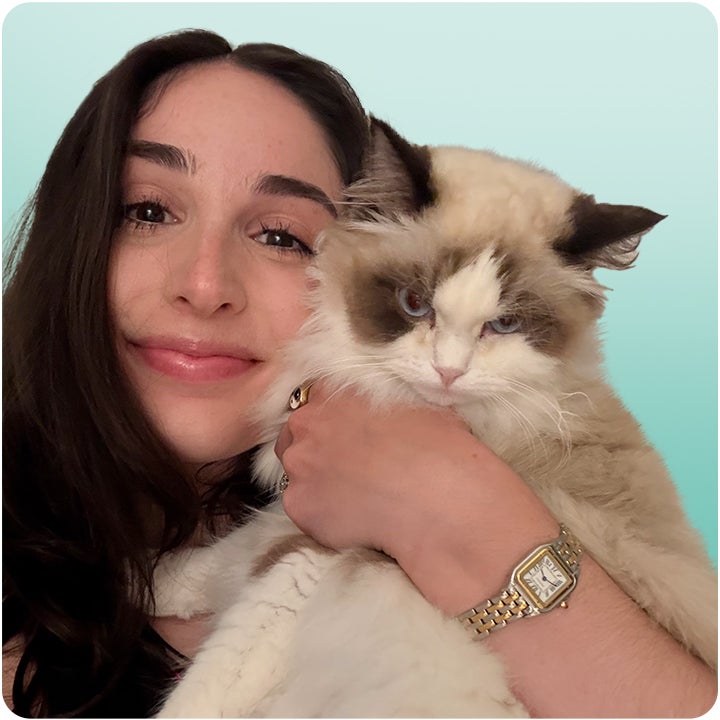In September 2024, I joined the nearly 43 million households that own a cat. I knew I wanted a pet at some point in my adult life, and once I began living on my own, it felt like the right time to take the plunge. My kitten, Fiona, fills my heart up daily, but she has been something of a drain on my bank account. I brought her home when she was about four months old, and she’ll be turning one in June. Since then, she’s had multiple ear infections, two eye infections and a prescription diet. She’s more of a diva than I originally anticipated, but I wouldn’t have her any other way; her high-maintenance antics are a large part of her charm. That, and her perpetual scowl.
I love my kitten, and I want to provide the best life possible for her, even if that means changing some parts of mine. For me, this meant accepting that some of my shoes will have permanent teeth marks, lint rollers are non-negotiable before leaving the house and that, at one point or another, I’ll have to drop some money on her. I crunched some of the numbers before bringing her home, but for added peace of mind, I also got a pet insurance policy. Having just purchased the policy nine months ago, I’ve already received more than twice the amount of money back in claims than I’ve paid in premiums.
How pet insurance works
Insurance for a four-legged friend works differently than it does for us bipeds. Instead of choosing a doctor that’s within your network, pet insurance typically works on a reimbursement basis.
Step 1: Pay for your pet’s medical care at the veterinarian or animal hospital. If your pet is prescribed any medication, you pay for that up front as well.
Step 2: Submit your receipts for reimbursement to your pet insurance company. You’ll also likely be asked to describe why you brought your pet in and the medical care they received.
Step 3: If your claim is covered, your pet insurance company will pay you back between 70 and 90 percent of the total cost, depending on your co-insurance. But, to get reimbursed, you’ll first need to meet your policy’s deductible.
Note: Some pet insurance providers do offer the option to pay vets directly.
Why I got pet insurance for my kitten
I live in San Francisco, the land of $12 beers and $15 artisanal breakfast sandwiches. Everything costs a little more here, and I knew pet care would not be an exception; the average cost of a cat vet bill in San Francisco is around $700. To compare, the national average cost of a routine vet visit is between $25 and $186.
As a first-time pet owner, I knew I’d have questions I’d rather ask a vet in person. I can be a bit of an overthinker, and I’d rather ask a medical professional than send myself down a rabbit hole of online research. If I’m scheduling a vet visit for my kitten, odds are, I’m already stressed that something is up. I didn’t want to be stressed about the cost of bringing her in on top of that.
I’d also heard horror stories from friends (mostly dog owners) about just how quickly a pet can go from fine one day, to costing you thousands the next. A friend of a friend of mine’s dog swallowed part of a rope chew toy, which resulted in her needing an MRI and surgery. The total bill ended up somewhere north of $20,000. Hearing that story was the push I needed to sign up for a policy before bringing my kitten home (I don’t have $20,000 burning a hole in my pocket.)
I did some shopping around, but ultimately decided to bundle my pet insurance with my renters policy, which I get from Lemonade. I wanted something I could do entirely on my phone and Lemonade boasted a fast claims payout time. I knew that, if Fiona had an expensive vet bill, I didn’t want the charge hanging around on my credit card; ideally, I wanted a plan that would pay me back quickly for covered claims so I wouldn’t need to dip too far into my own savings. Signing up was easy, and I was offered a discount for housing the two policies with the same company.
I purchased an accident and illness policy, with two add-ons. The first is a preventative care package, which includes coverage for three vaccines, a wellness exam, a parasite test, blood test and FeLV/FIV test, up to my policy limits. It only covers those specific expenses — other preventative care isn’t in my policy. The other endorsement covers vet visit fees for accidents and illnesses. However, it doesn’t cover pre-existing conditions. Lemonade also offered coverage for physical therapy, behavioral conditions, dental illness and end-of-life care, but I opted to skip those. In total, I pay about $44 each month, and my policy deductible is $250.
Did pet insurance save me money?
Overall, my kitten insurance policy did end up saving me some money. The money I received back in claims outweighed what I spent out of pocket on my monthly premium. In total, I spent $398 on pet insurance premiums from August to April, and got $892 back from claims. Without a pet insurance policy, I would have spent $494 more out of pocket.
| Pet Expenses | Costs without pet insurance | Costs with pet insurance |
|---|---|---|
| Monthly Premiums | $0 | $398 |
| Vet Bills and Medications | $2,002 | $2,002 |
| Money Back from Insurance | $0 | $892 |
| Net Out-of-Pocket Expenses | $2,002 | $1,508 |
| Total Expenses/Savings | $2,002 spent | $494 saved |
The bulk of those veterinary bills stemmed from Fiona’s chronic ear infections. She’s a Ragdoll, and while they’re a healthy breed, they are known for their sensitive stomachs. My veterinarian told me that food allergies in pets can manifest as skin, ear and eye irritations — not just digestive issues. This made sense, given that she’d been eating the same food her whole life and had always demonstrated some kind of issue or discomfort.
Fiona’s ear and eye-related claims were covered, but other claims were denied. When she had an eye problem, my veterinarian suggested prescription strength flea and mite medicine. I asked for the prescription, but Lemonade denied the claim. While prescription medicine is covered, flea medication is considered a “preventative” measure and did not qualify for coverage. My preventative care add-on only covered a handful of specific things, and flea medicine wasn’t one of them.
The vet also put Fiona on a prescription diet, which isn’t covered by my policy. Her new food is expensive, around $50 for a 4-pound bag. While it’s more expensive than her original, if it keeps her from getting ear and eye infections, I’m hoping it will pay for itself over time. Again, Fiona is something of a diva, so the expensive diet is slightly vexing but not unexpected.
Does pet insurance cover prescription food?
Just because my kitten’s prescription diet wasn’t covered doesn’t mean it never is. Some pet insurance companies include prescription food as part of a base policy, while others may cover it if you purchase a wellness endorsement.
Pet insurance or savings account: Which is better?
If you have a pet, you know things can get expensive quickly. If you’re considering getting a pet, hopefully by now you’ve learned from me that you need to have a game plan. It’s going to cost money to add a furry loved one to your home.
Economic pawprint: What we spend on our pets
- In 2023, the pet industry added around $312 billion to the economy — up 3 percent from the year prior. (Michigan State University)
- Money spent on pets, pet services and products totaled $112.3 billion in 2024. (Michigan State University)
- Gen Z is the fastest-growing group of pet owners; they now outpace Millennials in the number of pets per household. (American Pet Products Association [APPA])
- 71 percent of U.S. households own a pet. (APPA)
- On average, pet owners spent $1,516 on their animals in 2024. This is on par with the annual average of $1,515 spent in 2023. (American Veterinary Medical Foundation [AVMF])
- Dog owners spent more than cat owners in 2024, $1,740 per year compared to $1,311. (AVMF)
- Only 28.2% of pet owners claimed they were “extremely satisfied” with the cost of veterinary services. (AVMF)
Before getting a kitten insurance policy, I’d heard through the grapevine that it’s most cost-effective to put money away in a savings account. I can see the logic behind this, but for me, it made the most sense to do both. Since getting Fiona, I’ve become more of a saver, putting more money away each month in a high-yield savings account. That way, I know I have enough money for things she may need that aren’t covered by pet insurance, and I can rely on my insurance company for major expenses. In terms of savings account vs. a pet insurance policy, I don’t see it as an either/or.

While I’m glad that pet insurance saved me some money, I am mainly glad I have it for more major expenses. If something serious were to happen to Fiona, if she got sick, ate something she wasn’t supposed to or broke her paw, I sleep better at night knowing I don’t have to shoulder the entire cost on my own. Plus, it leaves more room in my budget for cat toys.
Because I purchased my policy when Fiona was a kitten, she was a blank slate in terms of her pre-existing conditions. I knew I could schedule a vet appointment for a variety of possible issues, and that there is a solid chance those bills would be covered. That said, when her policy renews in late August, I won’t be surprised if her ears and eye infections are deemed “pre-existing conditions” and no longer covered by my policy. It’s possible that Lemonade will deem her ear and eye infections pre-existing conditions, as her problems began before my policy’s new renewal effective date. But, I’m hoping that her prescription diet solves the issue.
Bottom line
There’s no getting around it — pets can be expensive, but they’re worth every penny. Getting a pet is a financial decision, and in my experience, pet insurance helped. If you’re considering getting a puppy or kitten, pet insurance may be a wise choice. You don’t know what health issues your pet may face, and by getting pet insurance when they’re young, you’ll likely be able to get more of your claims covered.
Read the full article here









